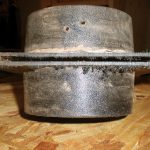We may receive a commission when you use our affiliate links. However, this does not impact our recommendations.
 Scientific Name: Juniperus virginiana
Scientific Name: Juniperus virginiana
Other Common Names: Juniper, aromatic cedar, pencil cedar, Tennessee red cedar
Growing Regions: Maine and southern Ontario to South Dakota, south to eastern Texas and east to Georgia
Size Characteristics: Generally grows to 50 feet tall, but can be as tall as 100 feet under ideal conditions. Trunk diameter is 2-4 feet.
Characteristics of Wood: Widely known to have a strong fragrance. The heartwood is bright red to reddish purple when freshly worked. Exposure to sunlight and air will darken it over time to a reddish brown. The white sapwood, which yellows over time, is sharply demarcated from the heartwood and is generally not sawn away when making lumber. Eastern red cedar has a very smooth, fine texture, but it tends to be knotty because most of it today comes from small trees.
Workability: Eastern red cedar works easily with both hand and power tools, but it has a tendency to chip when machined against the grain. The lumber is fairly weak and brittle but very stable once it is seasoned. The wood sands to a very smooth surface and glues very well. It’s wise to pre-bore for screws and fasteners to prevent splitting. The wood is not well suited to steam bending.
Common Uses: Eastern red cedar is used for blanker chests, hope chests, closers, cigar boxes, jewelry boxes, and novelties.
Availability: Eastern red cedar is generally widely available, but is usually cheaper in the eastern half of the country.
Wood Movement: It is a fairly stable wood, with minimum movement and shrinkage.
Finish Characteristics: If you wish to maintain the fragrance, don’t apply a finish. Otherwise lacquer or oil finishes work well for the exterior.
Special Features: Because of its fragrance, the wood has long had a reputation for repelling moths, but this is highly disputable.

End grain
Here are some supplies and tools we find essential in our everyday work around the shop. We may receive a commission from sales referred by our links; however, we have carefully selected these products for their usefulness and quality.









